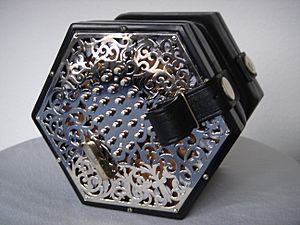English concertina facts for kids
The English concertina is a cool musical instrument that's part of the concertina family. It was invented in England in 1829. This instrument was actually the very first type of concertina ever made!
It's a fully chromatic instrument, which means it can play all the notes, including sharps and flats. Imagine a piano keyboard; a chromatic instrument can play all those notes. Its buttons are arranged in four rows. When you press a button, it makes the same sound whether you push or pull the bellows. This is called being unisonoric. What makes it special is how you play it: the notes of a scale are split between both hands. So, you play notes back and forth with each hand to make a tune.
Contents
History of the English Concertina
The English concertina was invented by Sir Charles Wheatstone. He received a patent for an instrument like it on December 19, 1829.
At first, people used the English concertina to play classical music. It was great for solos and small group music. By the 1860s and 1870s, it became popular in music hall shows. The Salvation Army also started using concertinas. They liked them because they were easy to carry and more flexible than big brass instruments. They even published books to teach people how to play complex music on the English concertina.
How the English Concertina Became Popular in Folk Music
English Folk Music Revival
In the 1960s, there was a big interest in traditional English music, called the English Folk Revival. Even though the English concertina was mostly used for classical music before, it became very popular with British folk musicians. Some people think its name, "English," helped attract players. But its ability to play many different styles and its small size were also important.
Alf Edwards was a key player. He often played with famous folk singers like A. L. Lloyd and Ewan MacColl. He also taught the instrument to Peggy Seeger. His amazing playing helped make the English concertina a favorite in the English folk music scene. You can hear his playing on important records like The Iron Muse.
Later in the 1960s, Alistair Anderson became famous for playing traditional dance music from Britain, especially from Northumbria. Many people who play English folk music today use the English concertina. Some well-known folk performers include Robert Harbron, Sandra Kerr, Graham Kennett, and the Scottish musician Simon Thoumire.
Irish Traditional Music
The English concertina wasn't used much in Irish traditional music. The Anglo concertina was much more common there. However, Rick Epping plays Irish music on the harmonica while also playing the English concertina.
South African Music
In South Africa, the traditional music of the Afrikaner people, called Boeremusiek, mostly used the Anglo concertina. But some English concertina players were also recorded.
When Boer musicians talked about the "4-ry" (four-row) concertina, they meant the English system. They sometimes used the word "English" to describe Anglo concertinas made by English companies like Lachenal & Co. and Wheatstone.
Latin American Music
While the bandoneon concertina was very popular in South America, the English concertina did gain some fans in Bolivia. This was especially true in the Cochabamba region. It's thought that foreign engineers working on the Bolivian Railway or in the Patiño mines might have brought the instrument there.
Playing the English Concertina
To hold the English concertina, you usually put your thumbs through straps. Your little fingers rest on metal supports. This leaves three fingers free to play the notes. Many players also use their little finger to play notes, so they use all four fingers. The thumb straps help hold the instrument up. Heavier concertinas sometimes have wrist straps or a neck sling for extra support.
The two rows of buttons closest to the center of the instrument make up a C major scale. These notes are split between your two hands. For example, C-E-G-B-d might be on one side, and D-F-A-c-e on the other. The two outer rows have the sharps and flats needed to play all the notes. This way of splitting notes between hands makes it easy to play fast melodies.
English concertinas come in different sizes. Treble and tenor-treble concertinas usually play 3.5 or 4 octaves. Baritones play one octave lower. Bass concertinas play two octaves lower, and contrabass concertinas play three octaves lower. Piccolo concertinas play one octave higher.
On most treble, baritone, and bass concertinas, middle C is on the button closest to you in the second row of the left hand. Tenor instruments might have the F below middle C in that spot.
Tenor, baritone, and bass concertinas often have an air valve. This button lets air in or out without making a sound. It's very important for many bass concertinas because their large reeds only make sound when you push the bellows.
Famous Players and Music
Giulio Regondi was a super talented performer and composer in the 1800s. He played both the English concertina and the guitar. He helped make the concertina very popular. When playing in Regondi's classical style, players use all four fingers, not just three. The metal finger rests are used only sometimes. This means all eight fingers can play at once, making it possible to play big chords. In pieces like the Bernhard Molique Concerto No 1, you can find chords with four, five, or even six notes. These would be very hard to play without using all your fingers.
Allan Atlas wrote a book called The Wheatstone Concertina in Victorian England. In it, he mentions six known concertos (pieces for a solo instrument with an orchestra) written for the English concertina.



